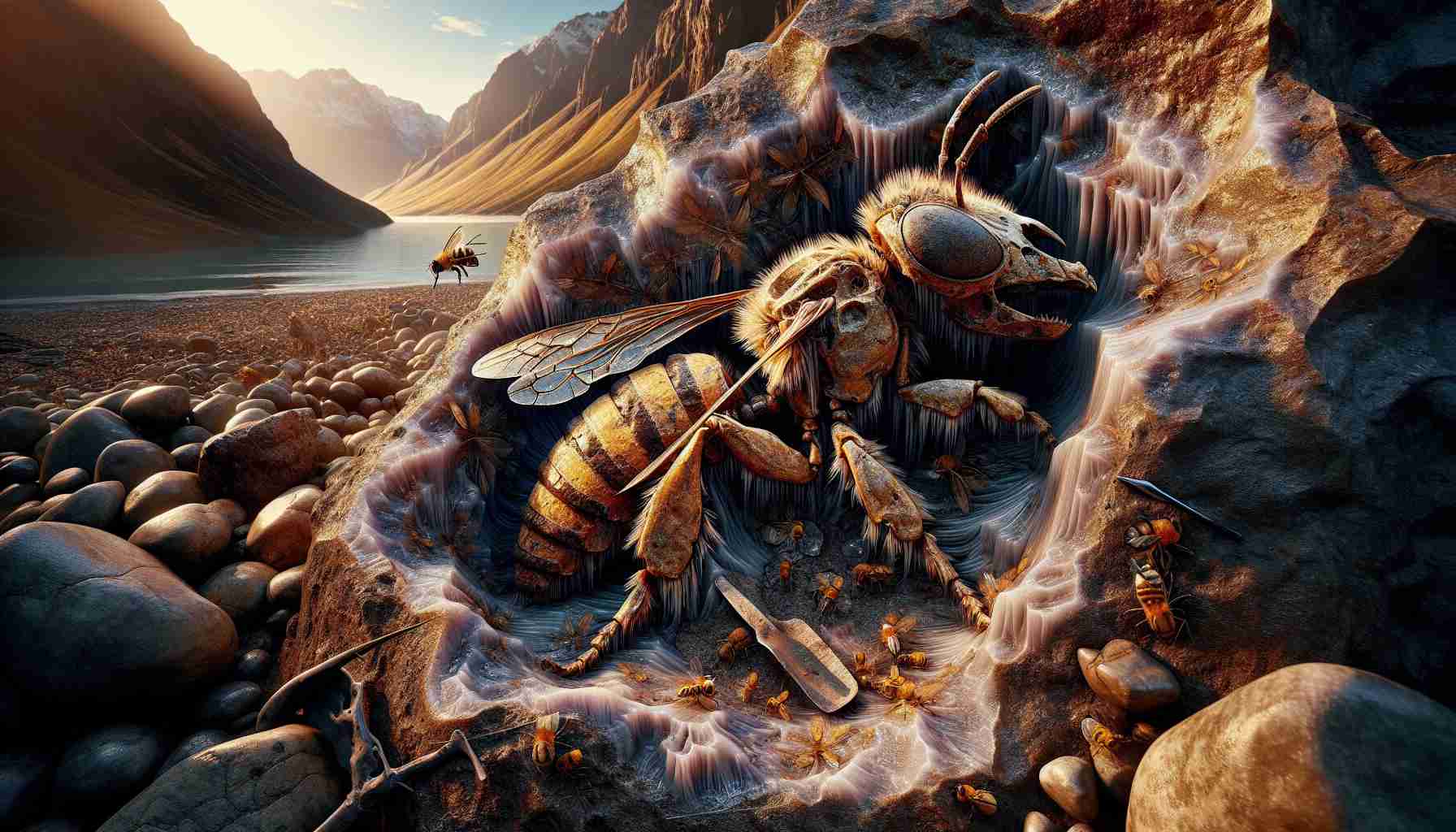- The discovery of Leioproctus barrydonovani enriches the understanding of New Zealand’s ancient ecosystems during the Middle Miocene epoch.
- This bee species, measuring 6.4 mm, indicates the significance of pollen-collecting insects in the lush flora of that time.
- The fossil reveals a connection to modern plant species, suggesting a long history of interactions between bees and local flora.
- New Zealand currently has 42 bee species, with low biodiversity prompting questions about historical extinction events.
- The find emphasizes the importance of ongoing research into the evolutionary history of bees and their ecological roles.
- Further studies could provide insights into the current biodiversity crisis and enhance understanding of environmental resilience.
In a groundbreaking revelation, paleontologists have uncovered a fossilized bee species, Leioproctus barrydonovani, from the ancient Middle Miocene epoch, approximately 14.6 million years ago, deep within New Zealand’s Hindon Maar deposits. This remarkable find not only adds a chapter to the story of the island’s ecosystem but also raises intriguing questions about the evolution of bee species in the region.
Measuring just 6.4 mm, this nearly complete specimen hints at a time when bees played a critical role in pollinating the blooming flora of lush broadleaf forests. The fossil, perfectly preserved in dark gray mudstone, reveals a creature that likely visited the vibrant flowers of Pseudopanax, a plant still common in New Zealand today.
Current estimates suggest that New Zealand hosts only 42 species of bees, with just 28 endemic varieties, hinting at a relatively recent arrival—until now. The presence of Leioproctus barrydonovani challenges this narrative, revealing a lineage that may have been exploring these landscapes long before! Researchers ponder the reasons behind the low diversity of modern bees, speculating on extinction events or complex ecological interactions that could explain why ancient species didn’t thrive as expected.
Amidst the stunning backdrop of New Zealand’s geological history, this find not only highlights the delicate balance of ancient ecosystems but also opens doors to future explorations—promising potential discoveries of even more fascinating insect-plant relationships. As we unearth remnants of the past, the crucial role of bees in our environment becomes clearer than ever. Would this ancient bee offer insights into today’s biodiversity crisis? Only time will tell!
Unveiling the Past: Ancient Bees and Their Role in Today’s Ecosystem
In a groundbreaking revelation, paleontologists have uncovered a fossilized bee species, Leioproctus barrydonovani, from the ancient Middle Miocene epoch, approximately 14.6 million years ago, deep within New Zealand’s Hindon Maar deposits. This remarkable find not only adds a chapter to the story of the island’s ecosystem, but also raises intriguing questions about the evolution of bee species in the region.
Key Features of Leioproctus barrydonovani
Measuring just 6.4 mm, this nearly complete specimen hints at a time when bees played a critical role in pollinating the blooming flora of lush broadleaf forests. The fossil, perfectly preserved in dark gray mudstone, reveals a creature that likely visited the vibrant flowers of Pseudopanax, a plant still common in New Zealand today.
Insights and Trends
Current estimates suggest that New Zealand hosts only 42 species of bees, with just 28 endemic varieties, hinting at a relatively recent arrival—until now. The presence of Leioproctus barrydonovani challenges this narrative, revealing a lineage that may have been exploring these landscapes long before!
Researchers ponder the reasons behind the low diversity of modern bees, speculating on extinction events or complex ecological interactions that could explain why ancient species didn’t thrive as expected. This discovery also raises questions about the ecological impact of bees on their environments over geological timescales.
Speculations About Future Studies
As scientists delve deeper into New Zealand’s geological history, the implications of this find extend beyond mere curiosity. It emphasizes the urgent need to understand the historical contexts of pollinators to comprehend current biodiversity issues. With future explorations promising to uncover even more fascinating insect-plant relationships, the role of bees in our environment becomes clearer than ever.
Important Questions
1. How did Leioproctus barrydonovani adapt to its environment?
– The adaptation might have involved specialized feeding habits adapted to local flora, hinting at ecological relationships with plants like Pseudopanax that persist today.
2. What does this fossil tell us about bee extinction events?
– The fossil’s presence suggests a longer history of bees in New Zealand, indicating that modern bee extinction might be a more complex process influenced by ecological changes and human impacts.
3. Can studying ancient bees inform conservation efforts today?
– Yes, understanding the historical diversity and ecological roles of bees may aid in developing targeted conservation strategies to restore pollinator populations and ecosystems.
Additional Insights
The discovery of Leioproctus barrydonovani highlights more than just the existence of an ancient bee species; it reflects broader themes of environmental change, resilience, and biodiversity. As paleontologists and ecologists work together, their combined insights will be crucial in combating the ongoing biodiversity crisis.
For more intriguing information about bees and biodiversity, check out ScienceDirect.













